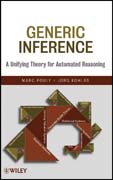
Generic inference: a unifying theory for automated reasoning
Pouly, Marc
Kohlas, Juerg
INDICE: List of Instances and Applications. List of Figures and Tables. Acknowledgments. Introduction. Part I. Local Computation. 1. Valuation Algebras. 1.1 Operations and Axioms. 1.2 First Examples. 1.3 Conclusion. 2. Inference Problems. 2.1 Graphs, Trees and Hypergraphs. 2.2 Knowledgebases and their Representation. 2.3 The Inference Probloem. 2.4 Conclusion. 3. Computing Single Queries. 3.1 Valuation Algebras with Variable Elimination. 3.2 Fusion and Bucker Elimination. 3.3 Valuation Algebras with Neutral Elements. 3.4 Valuation Algebras with Null Elements. 3.5 Local Computation as MessagePassing Scheme. 3.6 Covering Join Trees. 3.7 Join Tree Construction. 3.8 The Collect Algorithm. 3.9 Adjoining an Identity Element. 3.10 The Generalized Collect Algorithm. 3.11 An Application: The Fast Fourier Transform. 3.12 Conclusion. 4. Computing Multiple Queries. 4.1 The ShenoyShafer. 4.2 Valuation Algebras with Inverse Elements.4.3 The LauritzenSpiegelhalter Architecture. 4.4 The HUGIN Architecture. 4.5 The Idempotent Architecture. 4.6 Answering Uncovered Queries. 4.7 Scaling and Normalization. 4.8 Local Computation with Scaling. 4.9 Conclusion. Part II. Generic Constructions. 5. Semiring Valuation Algebras. 5.1 Semirings. 5.2 Semirings and Order. 5.3 Semiring Valuation Algebras. 5.4 Examples of Semiring Valuation Algebras. 5.5 Properties of Semiring Valuation Algebras. 5.6 Some Computational Aspects. 5.7 SetBased Semiring Valuation Algebras. 5.8 Properties of SetBased Semiring Valuation Algebras. 5.9 Conclusion. 6. Valuation Algebras for Path Problems. 6.1 Some Path Problem Examples. 6.2 The Algebraic Path Problem.6.3 QuasiRegular Semirings. 6.4 QuasiRegular Valuation Algebras. 6.5 Properties of QuasiRegular Valuation Algebras. 6.6 Kleene Algebras. 6.7 Kleene Valuation Algebras. 6.8 Properties of Kleene Valuation Algebras. 6.9 Further Path Problems. 6.10 Conclusion. 7. Language and Information. 7.1 Propositional Logic. 7.2 Linear Equations. 7.3 Information in Context. 7.4 Conclusion. Part III. Applications. 8. Dynamic Programming. 8.1 Solutions and Solution Extensions. 8.2Computing Solutions. 8.3 Optimization and Constraint Problems. 8.4 Computing Solutions of Optimization Problems. 8.5 Conclusion. 9. Sparse Matrix Techniques. 9.1 Systems of Linear Equations. 9.2 Symmetric, Positive Definite Matrices.9.3 Semiring Fixpoint Equation Systems. 9.4 Conclusion. 10. Gaussian Information. 10.1 Gaussian Systems and Potentials. 10.2 Generalized Gaussian Potentials. 10.3 Gaussian Information and Gaussian Potentials. 10.4 Valuation Algebra of Gaussian Potentials. 10.5 An Application: Gaussian Dynamic Systems. 10.6 An Application: Gaussian Bayesian Networks. 10.7 Conclusion. Appendix. Index. References.
- ISBN: 978-0-470-52701-6
- Editorial: John Wiley & Sons
- Encuadernacion: Cartoné
- Páginas: 250
- Fecha Publicación: 21/03/2011
- Nº Volúmenes: 1
- Idioma: Inglés
